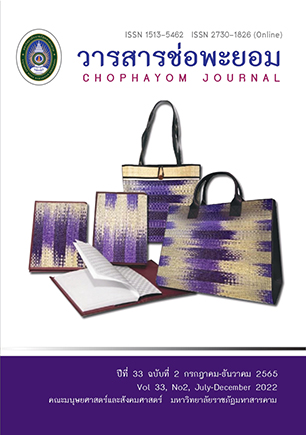King Xoumphou Inscription : Essence and New Suggestions for Tai Noi Alphabet Studies
Keywords:
King Sumphou, Inscription, EssenceAbstract
The article aims at studying King Xoumphou Inscription located in Wat Phra Yai Pha Hot Sanakham District, Laos PDR (opposite Chiangkhan District, Loei province, Thailand) in terms of content and characteristics of inscription alphabets. The results show that 1. The content of the inscription records when King Xoumphu promoted Chaohua Watklang to be Phra Maha Sami Chao (a high rank of Buddhism Sangha position) of Wat Mano and assigned skilled men to build the temple being built by the Phra Maha Sami Chao. King Xoumphou went to pay respect to Phra Maha Sami Chao at Wat Mano and donated land for the newly built temple. The king was blessed for the contribution to Buddhism by Phra Maha Sami Chao. The last line of the inscription mentions the 872nd year of the kingdom (2053 Buddhism year/1510 A.D.). The evidence contrasts with the Lan Chang history which issues the Buddhism year of 2044 as the last year of King Xoumphu’s life. That the inscription issues the year 2053 raises the discussion of the life of King Xoumphu. 2. Tai Noi alphabets and Tai-Lao language are used in the inscription. The influence of characteristics and structures of Fakkham script is noticed. Originally, scholars in paleography believed that the use of the Fakkham script was brought to the Lan Chang Kingdom in the era of King Vixoun (2044-2063 B.E./1501-1520 A.D.) and King Photisarath (2063-2090 B.E./1520-1547 A.D.) as issued in the Wat Dan Mueng inscription to be in the Buddhist year of 2073 (1530 A.D.). However, the piece of evidence found in King Xoumphou Inscription (2053) implies that the Tai Noi alphabets were developed before. Keywords: King Sumphou, Inscription, Essence
References
กรรณิการ์ วิมลเกษม. (2527). อักษรฝักขามที่พบในศิลาจารึกภาคเหนือ. นครปฐม : มหาวิทยาลัยศิลปากร.
ขุนบุรมราชาทิราช. Digital Library of Lao Manuscripts รหัส 0601241409902 ม้วนที่ 151 อันดับ 04). จาก https://digital.crossasia.org/digital-library-of-lao-manuscripts/?lang=en
ขุนบูลม ผูก 2. Digital Library of Lao Manuscripts รหัส 0101291400202) https://digital.crossasia.org/digital-libraryof-lao-manuscripts/?lang=en
ธวัช ปุณโณทก. (2530). ศิลาจารึกอีสาน. กรุงเทพฯ : คุณพินอักษรกิจ.
เติม วิภาคย์พจนกิจ. (2540) . ประวัติศาสตร์ลาว. กรุงเทพฯ : มูลนิธิโครงการตำราสังคมศาสตร์และมนุษย์ศาสตร์.
ประชุมพงศาวดาร. (2512). นิทานเรื่องขุนบรม. ประชุมพงศาวดาร เล่มที่ 44. (1-61). กรุงเทพฯ : องค์การค้าของคุรุสภา.
________. (2507). พงศาวดารเมืองหลวงพระบาง. ประชุมพงศาวดาร เล่ม 10 (135-236). กรุงเทพฯ : องค์การค้าของคุรุสภา.
________. (2506). พงศาวดารเมืองหลวงพระบาง ฉบับศาลาลูกขุน. ประชุมพงศาวดาร เล่ม 4 (315-369). กรุงเทพฯ : องค์การค้าของคุรุสภา.
________. (2506). พงศาวดารล้านช้าง (ตามถ้อยคำในฉบับเดิม). ประชุมพงศาวดาร เล่ม 2 (154-184). กรุงเทพฯ : องค์การค้าของคุรุสภา.
มาร์ติน สจ๊วต ฟอกซ์. (2556). ประวัติศาสตร์ลาว. (จิราภรณ์ วิญญรัตน์ แปล). กรุงเทพฯ : มูลนิธิโครงการตำราสังคมศาสตร์และมนุษยศาสตร์.
สุรศักดิ์ ศรีสำอาง. (2545). ลำดับกษัตริย์ลาว. กรุงเทพฯ : สำนักโบราณคดีและพิพิธภัณฑสถานแห่งชาติ กรมศิลปากร.
ศิลาจารึก. (2534). จารึกล้านนา ภาค 1 เล่ม 1: จารึกจังหวัดเชียงราย น่าน พะเยา แพร่. กรุงเทพฯ : มูลนิธิเจมส์ เอช ดับเบิ้ลยู ทอมป์สัน.
________. (2551). จารึกล้านนา ภาค 2 เล่ม 1: จารึกจังหวัดเชียงใหม่ ลำปาง ลำพูน และแม่ฮ่องสอน. กรุงเทพฯ : กรมศิลปากร.
Downloads
Published
How to Cite
Issue
Section
License
Copyright (c) 2022 Chophayom Journal

This work is licensed under a Creative Commons Attribution-NonCommercial-NoDerivatives 4.0 International License.






